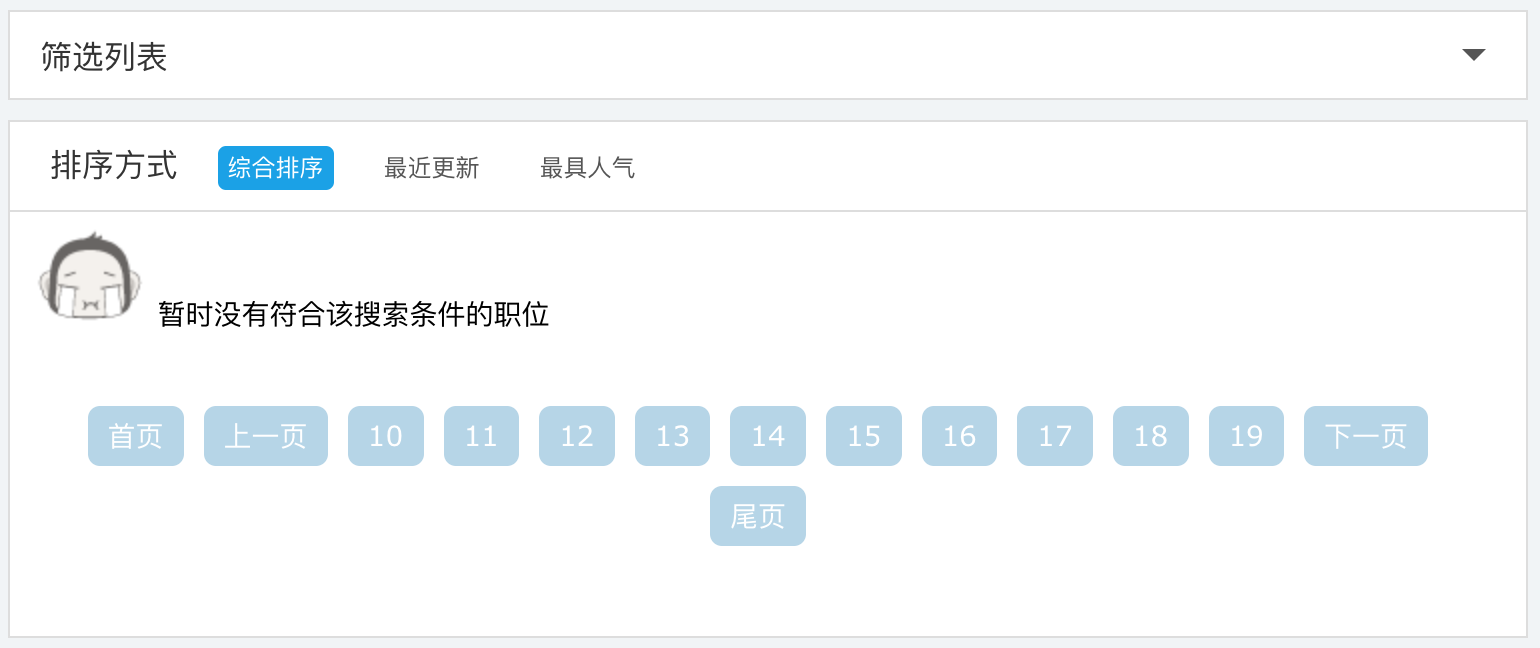scrapy的官方中文文档
源代码

上图是scrapy的数据流, 看不懂没关系, 接下来会简单介绍scrapy爬取的流程.
1
2
|
pip install scrapy # 安装scrapy
scrapy startproject shixiseng # 启动一个新项目,命名为shixiseng
|
接下来会在目录下看到以下结构:
1
2
3
4
5
6
7
8
9
10
|
shixiseng/
scrapy.cfg
shixiseng/
__init__.py
items.py
pipelines.py
settings.py
spiders/
__init__.py
...
|
我们重点关注的是以下几个文件:
spiders目录下的脚本负责解析和爬取网页信息 -> 将信息封装成items.py中定义好的格式(类似于python的dict) -> 传给pipelines.py处理得到的Item, 可以写入文件, 也可以传入数据库
-
在spiders目录下新建一个脚本, 命名为intern_spider.py
-
看看实习僧主页, 列出了一堆关键词, 随便找一个进入, 发现url格式很简单, 为http://www.shixiseng.com/interns?k=IOS&p=1, 其中k=搜索关键词, p=显示页数. 这个结构很简单, 不涉及复杂的js/ajax功能, 例如需要下拉才能刷新出信息等. 省却了很多麻烦

- 发现置空关键词的话, 只能显示出500页信息, 而实习信息远远不止这个数, 所以还是乖乖按关键词搜索吧. 把第一行的关键词输入一个list, 按照list一个一个爬就可以了, 见下:
1
2
3
4
5
6
7
|
# 爬取各种关键词
key_words = ['软件', 'IOS', '数据库', 'C#/.NET',
'Hadoop', 'Android', '算法', 'IT运维',
'Python', '云计算/大数据', 'Node.js', '数据挖掘',
'PHP', 'Ruby/Perl', '测试', 'Java',
'C/C++', '前端']
start_urls = ['http://www.shixiseng.com/interns?k=#&p=1'.replace('#', x) for x in key_words]
|
- 其中
start_urls就是scrapy开始爬取的链接, 我们组装出了18个关键词, 每次从搜索结果的第一页开始爬取, 一直爬到最后一页. 然而最后一页是第几页? 在不知情的情况下, 我们只能一直增加页数, 直到新的页面不能显示出实习信息为止, 像这样:

- 此时使用xpath搜不到显示实习信息的div就可以停止爬取了. 所以我们的
parse()函数, 即爬取一页信息的信息定义如下:
1
2
3
4
5
6
7
8
9
10
11
12
13
14
15
16
17
18
19
20
21
22
23
24
25
26
27
28
29
30
31
32
33
34
35
|
def parse(self, response):
# 初始化选择器和item
sel = Selector(response)
item = InternItem()
# 如果超出最大页数, 就不执行抓取
if sel.xpath(".//*[@id='load_box_item']/div").extract_first() is not None:
# 爬取一页的职业信息, 返回一个list
title = sel.xpath(".//*[@id='load_box_item']/div[*]/div/div/a/h3/text()").extract()
# 爬取指向每个信息的岗位职责子页面的链接
dec_link = sel.xpath(".//*[@id='load_box_item']/div[*]/div/div/a/@href").extract()
# 将爬取的unicode转换成utf-8字节码
# 每一页所有的候选框依次清洗并封装成wrapped_dict并缓存在item_list中
item_list = []
for i in range(len(title)):
# 把相对路径拼接成绝对路径
abs_link = 'http://www.shixiseng.com' + str(dec_link[i].encode('utf-8')
wrapped_dict = {'dec_link': abs_link),
'title': title[i].encode('utf-8'),
}
item_list.append(wrapped_dict)
# 按照每一个title对应的url爬取岗位职责, 同时通过meta传入打包好的item给parse_dec()
for i in range(len(item_list)):
yield Request(item_list[i]['dec_link'], callback=self.parse_dec, meta={'item': item_list[i]})
# 拼接好下一页的url并爬取下一页
next_page_index = int(response.url[-1]) + 1
next_page = response.url[:-1] + str(next_page_index)
yield Request(next_page, callback=self.parse)
else:
yield item # 直接返回空的item
|
介绍代码之前, 首先说明一下需要爬取的信息(源代码要复杂一点, 这里是简化版): title(职位), link(打开实习信息的链接), dec(实习信息, 需要在子页面爬取). 其中链接是在存储入数据库的时候用来区分是否重复的依据.
sel = Selector(response)这行把爬取到的信息初始化为一个选择器, 可以通过调用xpath()(xpath选择器), css()(css选择器), re()(正则表达式)等方法提取需要的信息- 首先通过
xpath()方法利用xpath提取需要的信息, 再使用extract()提取得到的文本list, 否则会返回一个Object而不是文本.
- 获取title和dec_link之后, 配对封装成
wrapped_dict, 放到item_list中备用
- 提取到每个实习信息的dict, 通过
Request(item_list[i]['dec_link'], callback=self.parse_dec, meta={'item': item_list[i]})发出请求爬取子页面
- 解释一下这里的
Request()函数:
- 首先,
Request()返回一个response类, 其中包含了请求获得的网页信息, 以及自己传入的一些参数.
- 第一个参数是需要爬取的url
- 第二个参数是调用相应的函数处理爬取的信息, 这里会调用自己写好的
parse_dec()函数处理这个Request的response.
- 第三个参数
meta={'item': item_list[i]})将前面爬到的信息传入这里的response.
- 下一步, 在
parse_dec()中将爬取子页面的信息和之前传入的信息合并并交给pipelines处理, 见之后介绍parse_dec()的部分
- 处理结束之后, 只爬取到了一页的信息, 接下来还要去下一页, 拼接好
next_page之后, 使用Request(next_page, callback=self.parse)调用自己爬取下一页, 如果下一页没有信息了, 就直接返回空的item交给pipelines.
1
2
3
4
5
6
7
8
9
10
|
# 爬取岗位职责页面, 和之前的信息拼接成item并传给pipelines
def parse_dec(self, response):
sel = Selector(response)
# # 接收之前传入的meta
item = response.meta['item']
# 职位描述和截止日期
dec_list = sel.xpath(".//*[@id='container']/div[1]/div[1]/div[3]//text()").extract()
item['dec_content'] = [x.encode('utf-8') for x in dec_list]
yield item # 返回爬取一个候选框的信息给pipeline处理
|
介绍一下这段代码
- 首先, 之前爬取的职位和链接信息都包含在了
response的meta参数里面了, 通过item = response.meta['item']把他们传入item.
- 其次, 通过新增
'dec_content'键, 继续往item里添加爬取到的信息, 最后返回item, 给pipeline处理.
整个爬取的流程如下
1
2
3
4
5
6
7
8
9
10
11
12
13
14
15
|
parse()page1 --item(title1,link1)--> parse_dec()爬取子页面1 --item(title1,link1,dec1)--> pipelinesc处理
--item(title2,link2)--> parse_dec()爬取子页面2 --item(title2,link2,dec2)--> pipelinesc处理
...
--item(title9,link9)--> parse_dec()爬取子页面9 --item(title9,link9,dec9)--> pipelinesc处理
parse()进入第二页爬取
parse()page2 --item(title1,link1)--> parse_dec()爬取子页面1 --item(title1,link1,dec1)--> pipelinesc处理
--item(title2,link2)--> parse_dec()爬取子页面2 --item(title2,link2,dec2)--> pipelinesc处理
...
--item(title9,link9)--> parse_dec()爬取子页面9 --item(title9,link9,dec9)--> pipelinesc处理
...
parse()进入下一页, 找不到信息, 爬虫停止.
|
1
2
3
4
5
6
7
8
9
10
11
12
13
14
15
16
17
18
19
20
21
22
23
24
25
26
27
|
class MongoPipeline(object):
# 这个pipeline是保存到数据库中的
collection_name = 'interns'
def __init__(self, mongo_uri, mongo_db):
self.mongo_uri = mongo_uri
self.mongo_db = mongo_db
@classmethod
def from_crawler(cls, crawler):
return cls(
mongo_uri=crawler.settings.get('MONGO_URI'),
mongo_db=crawler.settings.get('MONGO_DATABASE', 'shixiseng_interns')
)
def open_spider(self, spider):
self.client = pymongo.MongoClient(self.mongo_uri)
self.db = self.client[self.mongo_db]
def close_spider(self, spider):
self.client.close()
def process_item(self, item, spider):
# 通过dec_link, 即岗位职责页面的链接来判断是否重复, 若重复就不存入数据库
if self.db[self.collection_name].find({'dec_link': item['dec_link']}).count() == 0:
self.db[self.collection_name].insert_one(dict(item))
return item
|
- 处理获取的item相对简单, 只有
process_item()方法是必要的. 新建mongodb数据库名为shixiseng_interns, 新建collection名为interns
- 存入数据库之前先查询一下有没有相同链接的文档已经存在了, 如果存在就视为重复, 放弃存储.
- 通过
insert_one(dict(item)把item存入数据库
进入shixiseng根目录下, 运行
1
2
|
sudo service mongod start
scrapy crawl shixiseng_intern_spider
|
获得大量log信息, 爬取结束之后, 进入数据库查询:
1
2
3
4
5
6
7
8
9
10
11
12
13
14
15
16
17
18
19
20
21
22
23
24
25
26
27
28
29
|
{
"_id" : ObjectId("58a7ecbc44cefc2e49838e41"),
"addr" : "南京",
"title" : "产品策划(专题活动方向)实习生",
"closing_date" : "2017-12-31",
"money" : [
"70",
"90"
],
"dec_link" : "http://www.shixiseng.com/intern/inn_2oycacvj6eqw",
"dec_content" : [
"岗位职责:",
"1、负责与市场、运营等部门的线上专题页活动对接",
"2、通过对公司业务梳理和专题活动类型分析调研,挖掘需求",
"3、负责专题页的交互设计",
"4、组织活动需求方及研发、前端等资源确保产品按时高质交付",
"岗位职责:",
"1、负责与市场、运营等部门的线上专题页活动对接",
"2、通过对公司业务梳理和专题活动类型分析调研,挖掘需求",
"3、负责专题页的交互设计",
"4、组织活动需求方及研发、前端等资源确保产品按时高质交付"
],
"tag" : "软件",
"company_name" : "课窝教育",
"job_time" : [
"02",
"18 "
]
}
|
未完待续
Refer:


